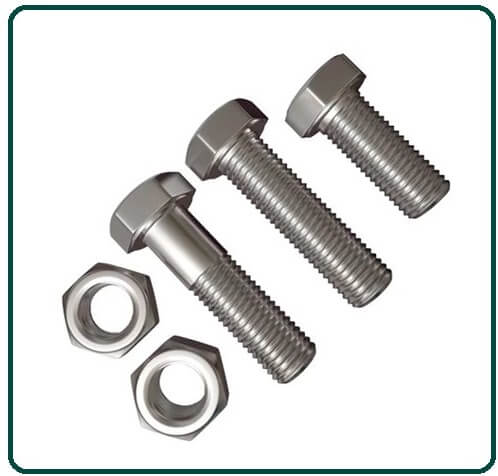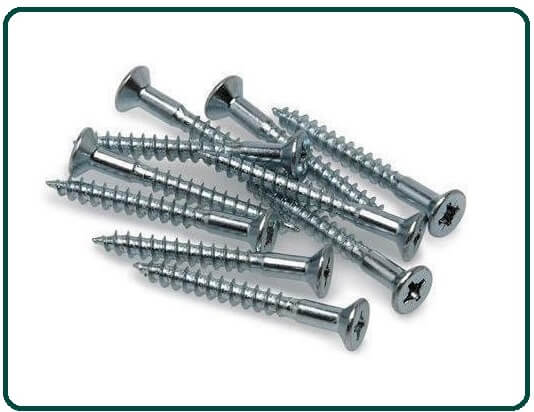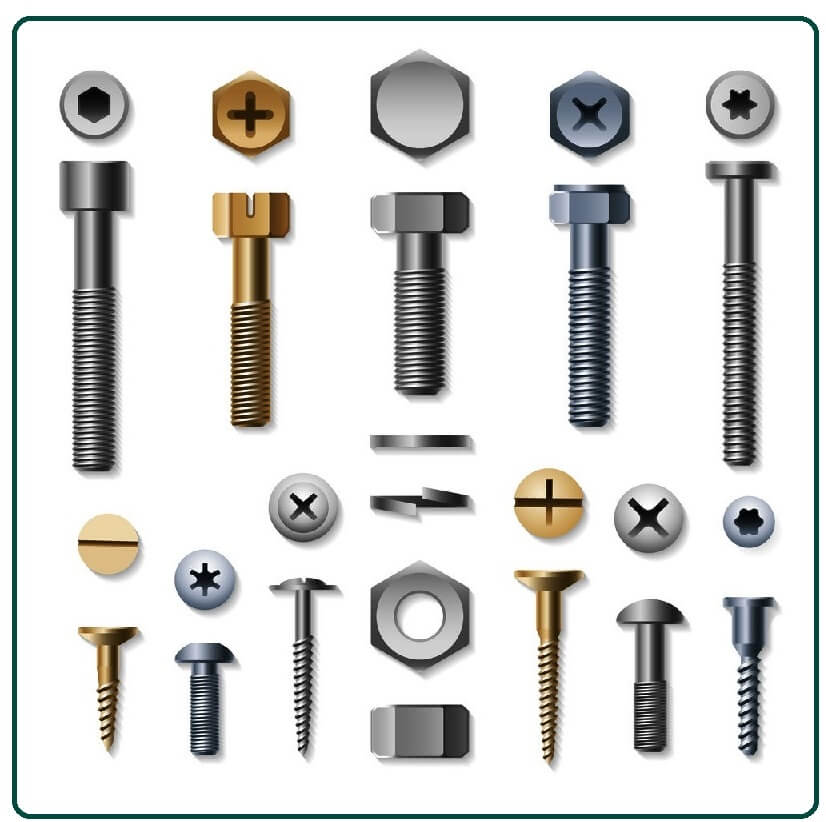
What Is Bolt?

Bolts are screws that rotate into matches nut to tighten them. The bolt head is larger than the shaft, with few exceptions. The carriage bolt and J-bolt are among those exceptions.
The shaft of the bolt is not tapered, whereas many of the screws are tapered. The main difference between a bolt and a screw is that a typical screw can work on its own, & a bolt requires a nut to secure it.
With the exception of the Handbook of Machinery, which states, “A bolts are an externally threaded fastener designed for insertions throughs holes in assembled parts, & is generally intended to be tightened or released by rotating the nut.”
screws are an externally threaded fastener capable of being inserted into holes in assembled parts, capable of mating with a prefabricated internal thread or forming its own thread and can be tightened or released by rotating the head.
“There are few places that attempt to define the difference between a screw & a bolt.” an important thing to remember is that each has its own purpose, & you should be careful in using the correct screw or bolt for the project you are working on.
Before choosing a bolt or nut for your project, you should find out what the bolt or screw is made of & what strength it is capable of.
Screws & bolts do many of the same things, but there are many different types, and you should consider what you need to do before choosing one or the other.
It is an externally threaded fastener designed for insertion through holes in assembled parts. Generally, bolts have a uniform circular cross-section area.
- Bolts are always used with nuts and mostly require a spanner and wrenches for loosening and tightening purposes.
- Bolted parts have greater strength and life. This makes the bolt a more reliable fastener.
- Bolts do not have a tapered shank but a cylinder shank of uniform cross-section area.
- Bolts apply compression to the parts to which they are bolted. Bolt is available in a variety of sizes ranging from smalls to very large.
What Is Screw?

If it has a head on one end, it is the screw. The head is turned or turned with a screwdriver or sometimes with a wrench. Diameter ranges vary to meet the demands and needs of specific products.
Screws usually turn into an object like a piece of wood, so the head needs to be larger than the surface. This prevents the screw from turning further than the length of the screw.
There are a few exceptions. For example, set screws have smaller heads & have special uses. There are some screws that are tightened counterclockwise, but most of them are tightened by turning them clockwise.
It is an externally threaded fastener capable of being inserted into holes in assembled parts. In most cases, a screw has a pointed tail.
- Screws are always used without nuts. The threads on screws are helical in structure and have a large pitch.
- Screws may or may not have a tapered shank, and tightening and loosening mostly requires screwdrivers or an alien.
- The parts connected by a screw have less strength than a bolt.
- Screws are available in small or medium sizes.
Difference Between Bolt and Screw:
The “differences between bolt and screw” is a very common question for most and can be easily answered with a basic description of both. Fasteners are used to fasten two or more objects together in a joint. Both bolts and screws belong to the same family of fasteners.
Bolts and screws also perform the same function of fastening objects together, share similar characters, and look very similar but have highly unique properties of their own.
Both have their own purpose for applications and should be used with proper knowledge. Misidentification of their application can result in a major error, especially in high-end applications.
Bolt VS Screw:

There are many differences between a screw & a bolt. The main differences between screw & bolt are given in the following table:
| S.no. | Bolts | Screws |
| 1 | Bolt is an externally threaded fastener that is designed for insertion through holes in assembled parts and is typically intended to be tightened or released by rotating a nut. | A screw is an external threads fastener capable of being inserted into holes in assembled parts, mated with a prefabricated internal thread or forming its own thread, and tightened or released by turning the head. |
| 2 | Bolts generally have similar cross-sections. | Screws generally have a non-uniform cross-section. |
| 3 | Bolts are always used with nuts. | It is not used with dry fruits but alone. |
| 4 | Threads on the bolts are spiral in structures. | The threads on screws are helical in structures. |
| 5 | It does not have a thin shank. | It has a slender or pointed leg. |
| 6 | Most wrenches and spanners are needed for the purposes of tightening and loosening bolts. | Most screwdrivers are needed for the purposes of tightening and loosening the screw. |
| 7 | The parts connected with a bolt have more strength than the screw | The parts connected with the screw have less strength than the bolt. |
| 8 | It is more reliable. | It is less reliable. |
| 9 | They apply compression to the parts to which they are attached. | They do not apply compression to the parts they are attached to. |
| 10 | The parts to be joined with the bolt must have holes for its insertions. | The Holes may or may not be required in parts that need to be attached to the screw. In most cases, it is screwed directly to parts to be joined. |
| 11 | Bolts are found in small as well as large sizes. | The size of the screw is smalls or medium. It is not found in very large sizes. |
| 12 | Examples of bolts are anchor bolt, carriage bolts, lift bolts, flange bolt, hanger bolts, hexagon bolt/tap bolt, lag bolts, machine bolts, plow bolts, sex bolt, shoulder bolts, square head bolts, stud bolts, timber Bolts, T-Head Bolts, Toggle Bolts, U-bolts, J-bolts, Eyebolts, etc. | Examples of screws are Wood Screw, Machine Screws, Thread Cutting Machine Screws, Sheet Metal Screws, Self Drilling SMS, Socket Screw, Eye Lag, Mating screws, Set Screw, etc. |
| 13 | The bolt has a hexagonal head, a threaded cylindrical body, and a chisel chamber at the bottom.
Bolts are typically used in conjunction with nuts. Bolt fasteners or bolts usually consist of 3 sections, top to front and bottom chamfers joined by a long cylindrical shaft with a helical ridge on the outer side known as a thread. As the chamfer has raised edges, it helps to slide the nut easily or even screw the bolt into the hole. Nuts are spun on these threads making it a tight joint. The primary purpose of a bolt is to hold two or more objects together. They also help position objects and make a joint stronger. Bolts and nuts together help to resist the loosening of joints due to vibration or torque. Different types of nuts can be used with different types of bolts, thus adding a dynamic range to the joint as required by the material or conditions. Bolts are commonly used in heavy-duty applications such as – concrete, studs, beams, etc. |
Screws are the type of fastener similar to a bolt. Screws are made of various alloys. Screws are used to fasten the components. The screw consists of a head part followed by a circular cylindrical body with external threads on it and a pointed end at the bottom. They dig and wedge into components when rotated. The thread cuts the groove into the fastening component, which helps to pull the fastening components together and helps to avoid pull-outs. Different types of screws are available for different types of components, and the most commonly used screws are wood, sheet metal, and plastic screws. Screws are used in light to medium applications (plywood, pressboard, drywall, sheet metal, deck plank, etc.) |
Applications of Bolts:
- Wind farms
- Solar thermal plant
- Nuclear power plants
- Railway
- Marine industry
- Sewage plant
- Pumps and valves
- Petrochemicals and Chemical Plants
- Oil and gas exploration rigs
- Paper and pulp industry
- Food processing industry
Application of Screws:
- Transportation and storage, pressure vessels, tanks, piping, & heat exchangers.
- Oil and gas exploration & processing equipment – piping, tubing, and heat exchangers cargo tanks for ships, high chloride environments,
- FGD / Effluent Scrubber System.
- Paper and pulp industry digesters, bleaching equipment and stock-handling systems, chip Pre-steam pots.
- Food Processing Equipment.
- Flue Gas Desulfurization / Cleaning Equipment
- The rotor, fan, shaft, and press roll are required to have combined strength and corrosion resistance.
- Biofuel Plants, Desalination Plants
- Firewalls and blast walls on offshore platforms
FAQs on Bolts and Screws
What Is a Bolt?
A bolt is an externally threaded fastener designed for insertion through holes in assembled parts. It typically requires a nut to be tightened or released. Bolts usually have a uniform circular cross-section and are used with wrenches or spanners.
What Is a Screw?
A screw is an externally threaded fastener capable of being inserted into holes in assembled parts. It can mate with a prefabricated internal thread or form its own thread and is tightened or released by rotating the head, typically using a screwdriver.
What Are the Main Differences Between a Bolt and a Screw?
The main differences include:
- Bolts are used with nuts, have uniform cross-sections, and are tightened with wrenches or spanners.
- Screws can be used without nuts, may have non-uniform cross-sections, and are tightened with screwdrivers.
Can Bolts Be Used Without Nuts?
Generally, bolts are designed to be used with nuts to secure them in place. However, certain types of bolts, like anchor bolts or J-bolts, can function without nuts in specific applications.
What Are Some Common Applications of Bolts?
Bolts are commonly used in heavy-duty applications such as:
- Wind farms
- Solar thermal plants
- Nuclear power plants
- Railway systems
- Marine industry
- Sewage plants
- Petrochemicals and chemical plants
- Oil and gas exploration rigs
What Are Some Common Applications of Screws?
Screws are used in light to medium applications, including:
- Plywood, pressboard, and drywall
- Sheet metal and deck planks
- Transportation and storage equipment
- Oil and gas processing equipment
- Food processing equipment
- Biofuel and desalination plants
How Do I Choose Between a Bolt and a Screw for My Project?
To choose between a bolt and a screw, consider the following:
- Strength requirements: Bolts offer higher strength and reliability.
- Application type: Screws are suitable for materials where internal threads can be created, while bolts are better for applications requiring high clamping force.
- Assembly method: Bolts typically need nuts and wrenches, while screws need screwdrivers.
What Materials Are Bolts and Screws Made Of?
Bolts and screws can be made from various materials, including steel, stainless steel, brass, and other alloys, depending on the application requirements such as strength, corrosion resistance, and environmental conditions.
Are There Special Types of Screws for Specific Applications?
Yes, there are various types of screws designed for specific applications, such as wood screws, machine screws, sheet metal screws, and self-drilling screws, each optimized for different materials and uses.
What Are Some Examples of Bolt and Screw Types?
Examples of bolts include anchor bolts, carriage bolts, hexagon bolts, and U-bolts. Examples of screws include wood screws, machine screws, sheet metal screws, and set screws.

